Honors Bio Unit 3: Evolution
1/47
There's no tags or description
Looks like no tags are added yet.
Name | Mastery | Learn | Test | Matching | Spaced |
|---|
No study sessions yet.
48 Terms
Evolution
The process of biological change in populations over time that makes descendants genetically different from their ancestors.
Two types of evolution
Microevolution & Macroevolution
Microevolution
Evolution can occur on a small scale affecting a single population
Macroevolution
Evolution on a large scale affecting changes in species across a population
Charles Darwin’s Theory
Natural Selection
Natural Selection
Organisms with the “best” traits (adaptations) will live longer and reproduce more than others,
causing changes in the population over time by acting on traits that are heritable.
Survival of the Fittest
Fitness
Based on:
Overproduction of offspring
Variation
Adaptation
Descent with modification
Fitness
A measure of how well you can survive in your environment and pass on your genes
Overproduction of Offspring
Lots of offspring and limited resources causes competition for those resources
Variation
Differences in the physical traits of organisms
Sources of Variation
Random mutations = ultimate source
Genetic recombination
Migration (gene flow)
Adaptation
A feature that allows an organism to better survive in its environment
Beneficial traits will become more common over time
Because organisms should live longer and thus be able to reproduce more
This changes the gene pool = combined alleles of all individuals in a population
Gene pool
The combined alleles of all individuals in a population
Descent with Modification
A change in gene frequency over time
Natural selection leads to populations with new phenotypes adapted to new situations
Their traits come from their ancestors
Beneficial traits should become more common over time
Individuals do not evolve, populations do!
An individuals does not evolve, because their allele frequencies don’t change. Populations evolved because their allele frequencies change.
Individuals in a population can be subject to natural selection, but the individual itself cannot ‘evolve’ in the biological sense of the world. They can only contribute to the evolution of a population by affecting the allele frequencies in that population.
Analogy: Pixels do not play, videos do.
3 Modes of Selection
Directional Selection
Disruptive Selection
Stabilizing Selction
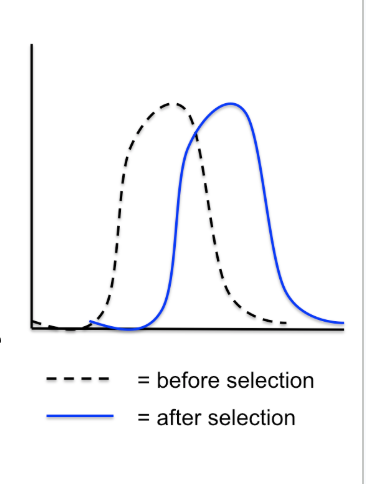
Directional Selection (Extreme)
Increases the expression of an extreme version of a trait in a population.
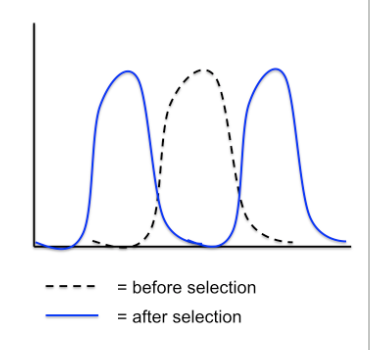
Disruptive Selection (2 groups)
A process that splits a population into 2 groups;
removes individuals with average traits and favors the two extremes
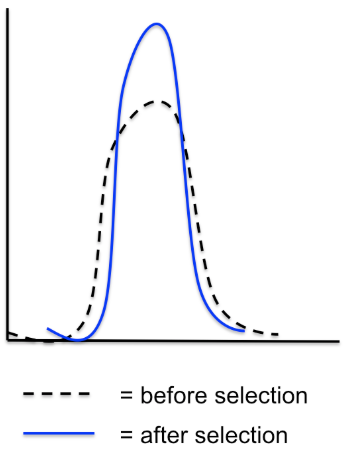
Stabilizing Selection (Average)
Eliminates extreme expressions of a trait when the average expression leads to higher fitness.
Allele Frequencies
Each allele has a frequency in a population’s gene pool
Allele Frequency
# of times the allele appears in a population (how common it is)
The higher the frequency = the greater the allele is there
(and the more common the trait is)Shows how frequently the allele appears in the gene pool
Gene pool = the combined alleles of all individuals in a population
p + q = 1
Formula for calculating frequencies
p = frequency of the dominant allele
q = frequency of the recessive allele
5 Mechanisms of Microevolution
Mutations
Natural Selection
Genetic Drift
Gene Flow
Non-random Mating (Sexual Selection)
Mutations
Any change in the DNA sequence
Creates new genotypes and thus new phenotypes
Changes the allele frequency too
Increases variation
Can be harmful, beneficial, or neutral
Genetic Drift
Random Change in the frequency of alleles in a population over time
Usually a sharp decrease in population size
Usually results in a loss of genetic variation
Gene Flow
The movement of genes into/out of a population
Occurs during migration
Results in an increase in genetic variation
Sexual Selection (Non-random Mating)
The selection of traits that aren’t necessarily good for survival fitness, but you can’t pass on your genes without them, because you can’t reproduce.
Genetic Equilibrium (Hardy-Weinberg Equilibrium)
When there are NO changes in the allele frequencies in a population over time.
Speciation
Forming of a new species by evolution from pre-existing species
Some sort of isolation must occur
Gene pools gradually become different and are no longer able to reproduce
The 2 groups are different species
Species
Group of organisms that can successfully interbreed and produce viable, fertile offspring.
Isolation
Separation of different population into smaller units,
to prevent interbreeding between distinct species
Types of Isolation
Geographical
Temporal = timing
Behavioral
Ecological = different niches (roles in the ecosystem)
Reproductive
Niche
Role in the ecosystem
Extinction
Elimination of a species
Gradual Extinction
Occurs at a slow rate
(eg. changes in climate, natural disasters)
Mass Extinction
Occurs when a catastrophic event changes the environment suddenly
(eg. massive volcano, tsunami)
Gradualism
Slow, constant changes over a long period of time.
Punctuated Equilibrium
Bursts of change → periods of stability
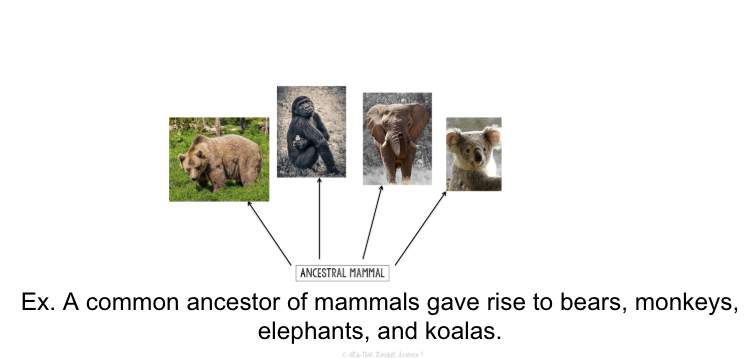
Divergent Evolution
A number of different species arise from one common ancestor
Adaptive Radiation
A type of divergent evolution occuring on a small scale over a shorter period of time
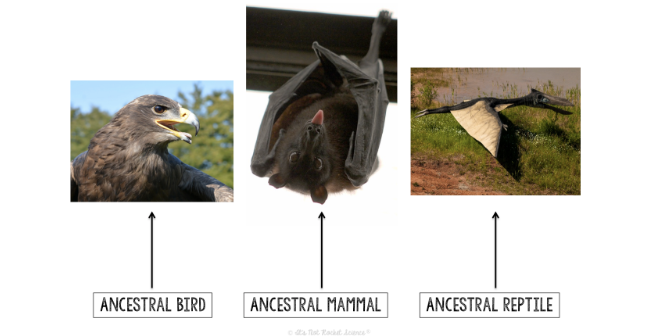
Convergent Evolution
When unrelated species evolve similar characteristics because they live in similar environments
Coevolution
Occurs when two populations of organisms form a specialized relationship and thus change in response to each other
(eg. flowers and the insects that pollinate them)
Taxonomy
Field of biology that classifies organisms
Organizes organisms by similar characteristics
Divided into 3 domains
Eubacteria = prokaryotes (“true bacteria”, like pathogens)
Archaebacteria = prokaryotes in extreme environments
Eukarya = eukaryotes
Then further subdivided
Bionomial nomenclature
2-name naming system
Genus species
Always in italics
First capitalized, second not
Phylogeny
Evolutionary history of a species
Works to piece together evolutionary history of relatedness based on shared inherited characteristics
Phylogenetic tree
A diagram used to predict evolutionary relationships among groups of organisms
Branch points show a news species diverging from the common ancestor
Classifies organisms into major taxa (groups) based on evolutionary relationships
Classifies groups of species in the order in which they descended from a common ancestor using homologous features
Any heritable traits (DNA, proteins, anatomical structures, etc.) that are the result of divergent evolution
Maximum Parsimony
Use the simplest explanation for creating the tree
What can we learn from a phylogenetic tree?
Which groups are most closely related
Which groups are least closely related
Which group diverged first (longest ago).
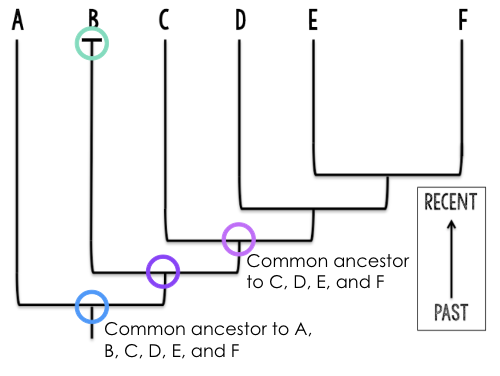
Reading Phylogenetic Trees
Start from the “root” = common ancestor
As you move away from the root, you move forward in time
Speciation = branching of a family tree
Extinction = loss of one of the branches
Each node represents a more recent common ancestor.